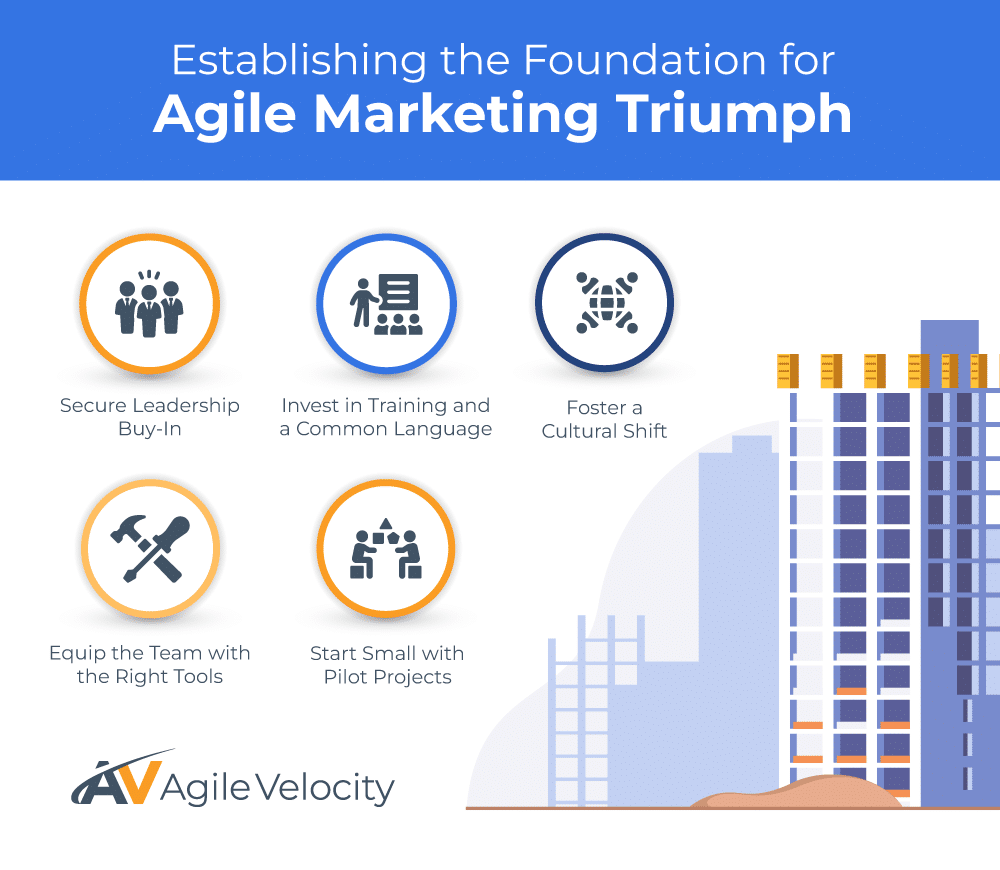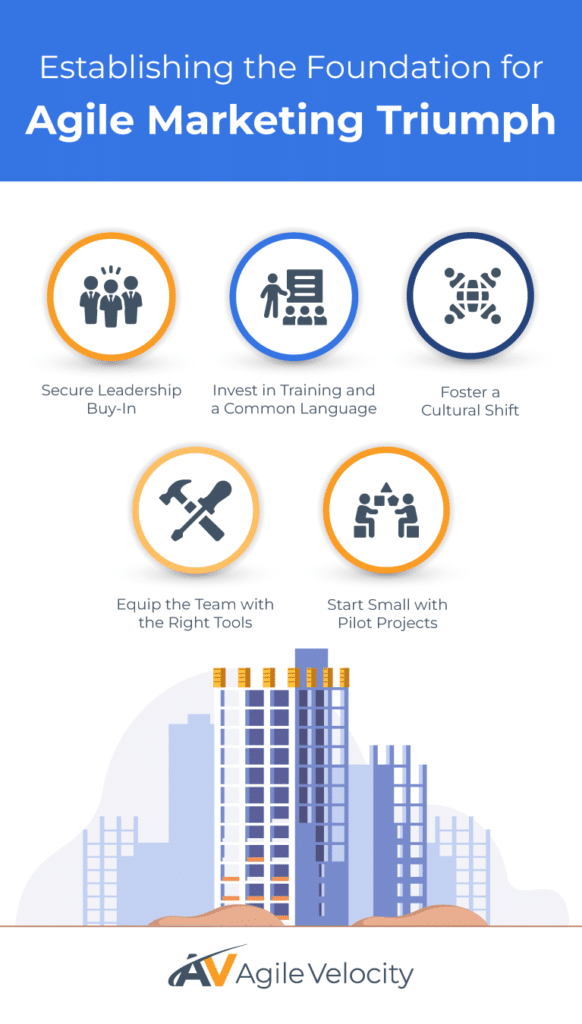Agile marketing is revolutionizing how marketing professionals approach their work, enabling teams to respond faster, collaborate more effectively, and deliver higher returns on investment. In today’s fast-evolving marketing landscape, traditional methods often fall short, struggling to keep pace with rapid changes. By assembling an Agile marketing team, organizations can adapt quickly to market shifts, leverage real-time data to refine strategies, and produce customer-focused outcomes that drive tangible results.
This guide will walk you through the steps needed to create and lead a high-performing Agile marketing team. You’ll uncover the key roles required within these teams, learn how to implement Agile frameworks, and explore the benefits of adopting Agile Methodologies for marketing success. Let’s explore how Agile can be the game-changer your marketing team needs to thrive.
Why Agile Marketing is Essential
Adopting an Agile Marketing mindset can transform the way teams work. By moving away from rigid, long-term planning processes, Agile marketing teams focus on flexibility, responsiveness, and customer-driven results. Unlike traditional methods that commit to lengthy campaigns or fixed deliverables, Agile enables marketing professionals to adapt and iterate based on real-time data and feedback.
The shift to Agile is fueled by the need for faster results and better alignment with customer needs. Instead of being locked into a static plan, Agile marketing teams prioritize short cycles, leveraging frameworks like Scrum and adapting Lean principles to execute, evaluate, and refine campaigns continuously. This iterative approach not only ensures relevance in a dynamic market but also lets teams pivot quickly when priorities change.
According to an Annual State of Agile Marketing Report, 51% of marketers are now using Agile practices to manage their work. This significant adoption highlights the growing recognition of Agile’s benefits in enhancing collaboration and responsiveness, even though it may not represent a universal preference across all marketing teams worldwide.
Benefits of an Agile Marketing Team
Shifting to an Agile marketing team revolutionizes how marketing departments operate, moving beyond outdated methods to create a framework that prioritizes adaptability, collaboration, and customer value. Here’s how Agile redefines success in marketing:
- Enhanced Adaptability – Agile Marketing Teams thrive on short cycles, such as Sprints or Iterations, where they continuously evaluate progress and adjust based on real-time feedback. This approach keeps teams aligned with current market conditions, reducing the risk of investing in ineffective campaigns.
- Accelerated Delivery – By breaking work into smaller, manageable increments, Agile teams speed up the journey from planning to execution. Whether launching a pilot campaign or iterating on previous efforts, the ability to act quickly gives businesses a competitive edge and accelerates impactful results.
- Improved Transparency and Collaboration – Agile fosters a culture of open communication and shared accountability. Eliminating silos means every team member remains aligned on goals and priorities. Visual tools like Kanban Boards keep everyone informed of progress and potential challenges throughout the campaign lifecycle.
- Customer-Driven Focus – At the heart of Agile is a commitment to delivering customer value. Through iterative processes and continuous feedback, teams can fine-tune campaigns to meet customer needs, enhancing the relevance of marketing initiatives and building stronger relationships with their audiences.
- Continuous Improvement – Agile integrates a mindset of ongoing learning and adaptation. Regular events like Sprint Retrospectives allow teams to assess what works and identify areas for enhancement, paving the way for more efficient processes and innovative strategies.
The transition to an Agile marketing team not only propels efficiency and adaptability but also establishes a culture of continuous improvement and customer-centricity. By adopting Agile Methodologies, organizations can seamlessly harmonize marketing efforts with real-time market dynamics and consumer demands, ensuring their strategies remain both relevant and effective.
Core Principles for Building an Agile Marketing Team
Transitioning from a traditional marketing approach to an Agile marketing team requires adopting key principles that foster collaboration, adaptability, and a results-driven mindset. These foundational principles serve as the bedrock for creating a team that delivers value efficiently in a fast-changing environment:
- Work in Iterative Cycles – Instead of committing to long, rigid marketing plans, Agile teams break their work into smaller increments. In Scrum, these increments are called Sprints, typically lasting 1-4 weeks. Other frameworks, such as the Scaled Agile Framework® (SAFe®), refer to these increments as Iterations. Short cycles allow teams to deliver targeted outcomes and remain responsive to change.
- Foster Transparency – Open communication is crucial. Every team member should have visibility into ongoing tasks. Visual tools like Kanban Boards promote transparency by tracking tasks from initiation to completion, ensuring alignment and accountability.
- Adapt to Change – Change is inevitable. Agile marketing teams embrace rapid iteration, enabling them to respond quickly to shifting customer preferences, emerging data insights, or unforeseen challenges by refining tactics as needed.
- Prioritize Customer Value – Each marketing initiative should directly deliver value to the customer. Agile teams focus on creating campaigns that maximize engagement through short feedback loops and iterative testing.
- Encourage Cross-Functional Collaboration – Successful Agile marketing teams leverage diverse skills. By uniting content creators, designers, data analysts, and other professionals, teams collaborate seamlessly to produce cohesive, high-impact campaigns.
An Agile approach empowers teams to remain agile yet focused, creating a harmonious environment that promotes innovation and value-driven results. By consistently emphasizing agility, transparency, and collaboration, marketing departments can maintain a competitive edge, adapting quickly to market trends and effectively meeting customer expectations. This strategic alignment not only leads to more successful campaigns but fosters a culture of continuous improvement and mutual respect among team members.
Laying the Groundwork for Agile Marketing Success
Shifting to Agile marketing requires a solid foundation. With strong leadership support, the right tools, and a commitment to change, marketing teams can transition smoothly to an Agile approach. Consider these key steps:
- Secure Leadership Buy-In – Leaders must clearly communicate the vision, allocate necessary resources, and actively remove obstacles. Their support builds trust and empowers the team to experiment and iterate.
- Invest in Training and a Common Language – Educate your team on Agile fundamentals through workshops or training sessions. Bringing in an Agile Coach can clarify key concepts such as visualizing work, Sprints, Daily Scrum, and Iterations, ensuring everyone understands their role. Specialized training for marketing teams can help simplify the learning curve.
- Foster a Cultural Shift – Agile marketing thrives in an environment of open communication, accountability, and continuous learning. Cultivate a culture where the team takes ownership of outcomes and views mistakes as opportunities for growth.
- Equip the Team with the Right Tools – Agile thrives on visualizing work. Utilize digital boards to map tasks in real time. Tools such as Path to Agility Navigator, which is built to assess, plan, and track progress through Agile Transformations, can be instrumental in maintaining transparency and accountability—even if it is not designed exclusively for marketing.
- Start Small with Pilot Projects – Begin with a manageable campaign or initiative to test Agile practices. A small pilot project allows your team to refine workflows, identify early wins, and build momentum for a broader Agile Transformation.
Cultivating an Agile marketing environment demands more than just theoretical understanding; it requires dedication to nurturing a transformative mindset across the team. By empowering leadership, fostering a culture of innovation, and utilizing tailored tools, marketing departments can effectively bridge the gap between traditional practices and Agile methodologies. The integration of these elements not only amplifies efficiency and engagement but also entrenches a sense of shared purpose and commitment to excellence. Initiating change at a scalable pace ensures that Agile marketing becomes ingrained in the team’s ethos, paving the way for sustained success in an ever-evolving market landscape.
Key Roles and Responsibilities in an Agile Marketing Team

A successful Agile approach for marketing thrives on clarity, accountability, and collaboration. Similar to Scrum Teams in software development, Agile marketing teams rely on specific roles to drive customer-focused and iterative campaigns. The following core roles are vital:
Marketing Product Owner
The Marketing Product Owner is the strategic decision-maker who sets the vision and priorities for the team. By developing and maintaining a Marketing Backlog, they ensure that tasks and initiatives align with business goals and customer needs, keeping the team focused on delivering high-value outcomes.
Scrum Master or Agile Marketing Coach
The Scrum Master or Agile Coach guides the team toward Agile excellence. Acting as a facilitator, this role helps enforce Agile principles by ensuring key events such as Daily Scrum, Sprint Planning, Sprint Review, and Retrospective are productive. They work to remove obstacles and promote self-organization and cross-functional collaboration.
Core Marketing Team Members
These team members bring together diverse skills such as content creation, social media management, design, and data analysis. Collaboration among these experts is essential for refining campaign tasks, responding to shifting priorities, and ensuring that marketing efforts are cohesive and effective.
Stakeholders and Extended Contributors
While not part of the day-to-day operations, stakeholders including department heads, senior leadership, and external contributors offer valuable input that shapes marketing priorities. Their feedback, typically gathered during structured events like the Sprint Review, ensures alignment with broader organizational goals.
Choosing the Right Framework for Your Agile Marketing Team
Selecting a suitable Agile framework is crucial to drive successful outcomes. The choice depends on your team’s structure, project nature, and adaptability. Below are some effective frameworks:
Scrum
Scrum organizes work into time-boxed cycles called Sprints, usually lasting one to four weeks. Each Sprint starts with planning, incorporates Daily Scrum for real-time alignment, and concludes with a Sprint Review and Retrospective for feedback and improvement. Scrum is ideal for campaign-based projects with clearly defined deliverables.
Kanban
Kanban emphasizes continuous workflow management using visual boards to track tasks through stages like “To Do,” “Reviewing,” “In Progress,” and “Done.” Limiting Work In Progress (WIP) helps prevent bottlenecks, making Kanban suitable for teams handling diverse, ad-hoc tasks.
Scrum@Scale™
For larger teams, Scrum@Scale™ enables multiple smaller teams to work independently while staying aligned with broader objectives. This framework supports coordination across interconnected campaigns.
SAFe® (Scaled Agile Framework®)
SAFe is designed for large organizations requiring coordination between marketing and other business units. It breaks work into Iterations and Planning Intervals (PIs), emphasizing strategic alignment through defined roles such as the Agile Release Train (ART) and the Business Owner (BO). During those intervals, marketers define PI Objectives to ensure that each Planning Interval drives outcomes aligned with overarching strategic goals. By structuring work in clear increments, SAFe helps large-scale marketing initiatives remain coordinated and effective across diverse stakeholders.
For Product companies, SAFe also provides an effective means of building marketing campaigns around the features and solutions being developed. Agile Marketing teams can align their calendars and work activities with the development teams to reduce the time and overhead of collaboration and feedback.
Large-Scale Scrum (LeSS)
Large-Scale Scrum (LeSS) extends Scrum principles across multiple teams, making it suitable for large, complex projects that demand structured collaboration across regions or departments.
Disciplined Agile (DA)
Disciplined Agile® (DA™) offers a versatile toolkit that combines Agile and Lean practices. It is particularly useful for marketing teams managing varied tasks that benefit from a flexible, tailored approach.
Choosing the right Agile framework is essential for optimizing performance and achieving desired outcomes in marketing initiatives. Whether you’re managing clearly defined, campaign-based projects or handling a variety of ad-hoc tasks, there is a framework designed to fit your needs. Scrum is ideal for structured projects requiring precise deliverables, while Kanban excels in managing continuous workflow and diverse tasks. Larger teams or organizations may benefit from Scrum@Scale, SAFe, or LeSS, which enable collaborative efforts across interconnected campaigns and departments. For a customized approach, Disciplined Agile provides agility and adaptability by merging Agile and Lean practices. Selecting a suitable framework not only enhances team efficiency and alignment but also ensures marketing strategies remain responsive and effective in an ever-changing landscape.
Step-by-Step Guide to Transitioning From Traditional Marketing to Agile Marketing
Transitioning to an Agile marketing team requires thoughtful planning and a willingness to experiment. Here’s a practical guide:
- Start by Evaluating Your Current Marketing Setup – Identify inefficiencies, map out current processes, and pinpoint areas where Agile can enhance turnaround times and collaboration.
- Educate and Train Your Team – Introduce your team to Agile fundamentals through workshops or training sessions. Consider guidance from an experienced coach to help clarify roles and practices.
- Launch a Pilot Project – Select a specific campaign and form a small, cross-functional team to apply Agile practices using frameworks like Scrum or Kanban. This pilot will reveal early wins and areas for improvement.
- Integrate Core Agile Events – Introduce Daily Scrum, Sprint Planning sessions, Sprint Review, and Retrospective to maintain structure and ensure continuous, actionable feedback.
- Visualize Workflows – Use boards to create transparency, track progress, and expose potential bottlenecks. This approach facilitates better team coordination.
- Embrace Feedback Loops – Regularly gather feedback on campaign elements to enable real-time adjustments and optimize outcomes.
- Expand Incrementally – Once the pilot project has produced valuable lessons, gradually extend Agile methods to additional campaigns or teams. For larger initiatives, consider scaling frameworks such as Scrum@Scale™.
- Track Metrics and Reflect – Monitor performance using key indicators like engagement rates and campaign turnaround times. Analyzing these insights allows for timely tactical adjustments.
- Celebrate and Share Wins – Recognize achievements to boost morale and demonstrate the value of Agile practices, thereby encouraging broader adoption across the organization.
By following these steps, your marketing team can transition toward Agile Methodologies in a structured, manageable way, ultimately driving improved performance and customer-focused outcomes.
Continuous improvement and Tracking Progress

At the core of a successful Agile marketing team lies an unwavering commitment to continuous improvement, a mindset that perpetually enhances workflows and maintains resilience in a dynamic market environment. A vital practice is conducting regular retrospectives. After each iteration, teams allocate time to reflect on their accomplishments and scrutinize opportunities for improvement, thereby allowing for the iterative refinement of processes. This retrospective analysis is crucial for maintaining one of Agile’s core tenets: the ability to pivot and adapt promptly.
In addition to retrospectives, making data-driven decisions is essential for tracking progress and optimizing outcomes. Monitoring key performance indicators, such as engagement rates and campaign turnaround times, provides the insights necessary to make real-time adjustments. These metrics serve as the compass guiding marketing strategies, ensuring they remain aligned with dynamic consumer demands and business objectives.
Moreover, ongoing learning is a critical element of continuous improvement. Equipping teams with advanced Agile skills through targeted workshops and training sessions fosters an environment of perpetual growth and innovation. As the marketing landscape continues to evolve rapidly, staying informed and adept ensures the team can effectively navigate emerging challenges and capitalize on new opportunities. In sum, this holistic approach to continuous improvement solidifies an Agile marketing team’s ability to adapt and excel over the long term.
Embrace Agile Marketing for Future-Ready Success
Building a high-performing Agile marketing team can transform how your organization executes campaigns, engages with customers, and adapts to constant change. By embracing iterative work cycles, fostering collaboration, and maintaining a customer-first mindset, your team can deliver faster and more impactful results.
Ready to revolutionize your marketing efforts? Partner with Agile Velocity for expert guidance through Agile coaching, customized training programs, and strategic tools like Path to Agility Navigator. Take the first step toward building your high-performing Agile marketing team and drive results that truly matter.





